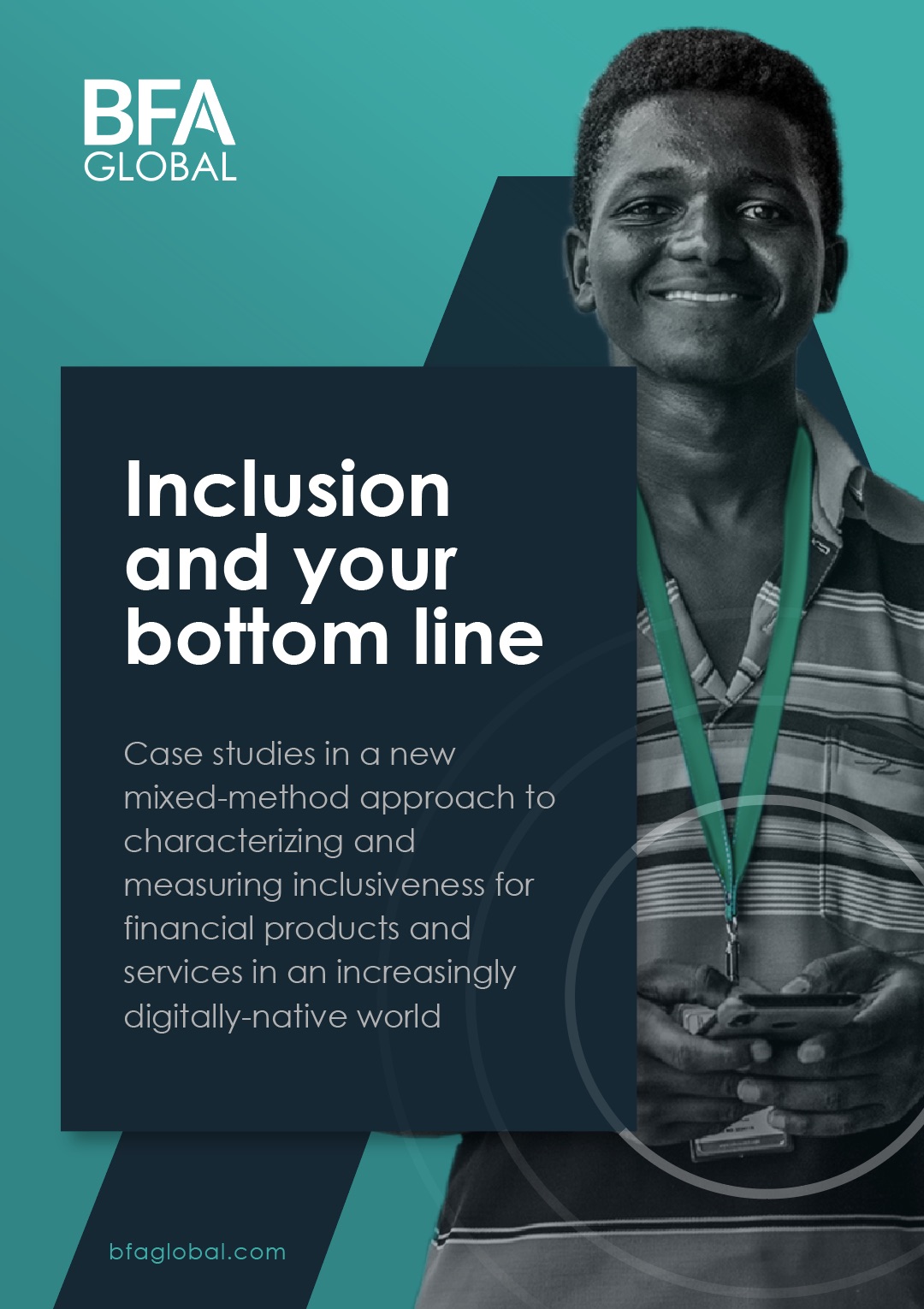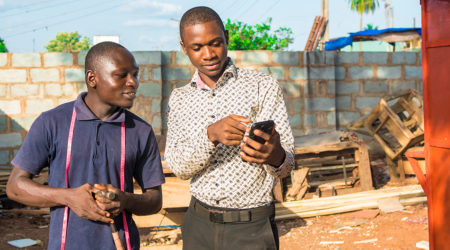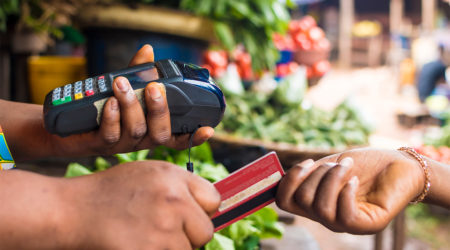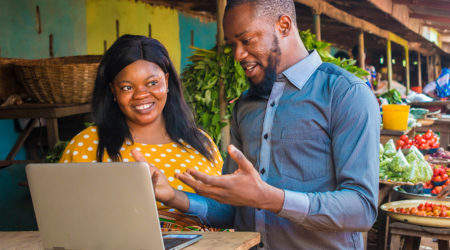Transaction product mystery shopping in Kenya, Nigeria and South Africa: What are the unexpected barriers and experiences customers might face?

This is the third case study in our report, ‘Inclusion and Your Bottom Line’, which outlines a new mixed-method approach to characterizing and measuring inclusiveness for financial products and services.
Through quantitative and qualitative customer research conducted with over 1,500 active digital transactors in Kenya, South Africa, and Nigeria, we sought to determine what makes transaction products truly inclusive in the eyes of the customers. We validated factors that drive initial adoption of new transaction products, and those that contribute significantly to higher usage for existing accounts. Specifically, we then questioned the feasibility of affordability as a preferred product characteristic and arrived at three key conclusions:
1. The perception of affordability is a vital factor in contributing to a customer’s decision to open an account.
2. However, customers have a poor understanding of the exact charges they incur for various transactions. In addition, we found that customers make use of heuristics (mental shortcuts) to determine whether they consider an offering affordable or not. For instance, they:
- reference known charges from other players in the market that they might have used before as a benchmark;
- use their own yardstick of affordability (e.g. a particular figure under which a customer would consider fees to be affordable);
- reference a specific charge (say of their most-used transaction) to determine whether a product was indeed affordable across the board – in other words they adapt their expectations based on past experiences rather than on the merits of the case at hand
Based on the above strategies, once customers conclude that a product is affordable based on a few transactions (e.g. their most frequent transactions), they conclude that other services must be affordable as well.
3. Transparency around charges is a much stronger driver of consistent usage. In other words, after the sign-up stage, the perception of transparency around charges is considered to be more important than the actual charges imposed when it comes to driving active and sustained usage.
Ultimately, affordability, when complemented by transparency around fees, plays a critical role in driving both the adoption and sustained usage of transaction products. This serves as a gateway to adoption of other financial services, hence, contributing to financial inclusion.
In order to understand what affordability and transparency around transaction product charges at major financial institutions really means in practice, we carried out a Mystery Shopping exercise in Kenya, South Africa, and Nigeria.
Methodology: Leveraging Mystery Shoppers to evaluate charges associated with transaction products
In this exercise, individuals were recruited to portray actual customers to gauge their experience. We evaluated two financial institutions per country – the market leader, and a challenger. The former is considered a larger, established transaction product provider with one of the highest customer bases, while the latter an innovative player gaining quick traction. For each, we compared fee information published by these institutions (published rates), vs what we found to be true when actually using the product (actual rates). We also compared user experiences for each country, and took note of any surprising elements that were uncovered while engaging with the various services offered.
We gathered published rates in Jan-Feb 2020, and carried out the mystery shopping in May 2020. In some instances, the COVID-19 interventions resulted in skewed results for the mystery shopping exercise, as Kenyan and South African governments imposed several fee waivers and other reductions in transaction charges after Jan-Feb 2020 to help customers cope with the socio-economic consequences of the crisis.
In these exercises, each account started with a US $50 equivalent transferred from a US bank account. All transactions netted to 0 (i.e. all withdrawals were matched with a deposit), so any decrease in value is attributed exclusively to fees. Figure 1 illustrates published fee rates, while Figure 2 illustrates actual rates we found during mystery shopping. Each line represents one institution, and names are redacted to honor our confidentiality agreement with partners. Not all transactions were consistent across the six institutions due to regulatory requirements, or the tech-oriented nature of the market challenger. In Figure two, we clubbed all the common transactions to the right of the blue dotted line for comparison, and transactions to the left, or starting from “balance inquiry – ATM” comprised the inconsistent transactions. In case of a transaction not offered, we kept the transaction charge to zero.
We found that:
The path to obtain and understand information on fees charged by financial service providers was murky
We were able to locate financial service providers’ transaction fees online most quickly in South Africa and Kenya but they were not always intuitively presented. For example, the Kenyan challenger offered an all-exhaustive downloadable PDF tariff guide that was last updated four years back. It was not easy to distinguish which fees related to some of the transactions we were interested in, probably because retail account fees were bundled with commercial account fees, and because of the inclusion of unique and rare charges that could have rather been placed in unique categories. Moreover, the charges did not include the additional 20% excise duty charges levied for most transactions although there was a disclaimer at the end indicating that all fees were exclusive of taxes, which placed the onus of determining and calculating the tax amount on the customer. Kenya’s market leader had published all fees inclusive of the taxes. However, on transacting, both provided SMS notifications that included the fees incurred.
On the other hand, Nigerian institutions do not publish any information on transaction fees online, as they follow the Central Bank of Nigeria’s guidelines to charge for transactions. The guidelines document is long, and fees for most basic financial transactions are not listed explicitly. Instead, they’re listed as “negotiable” by the institution.
On-boarding costs and cash withdrawals were the most significant costs
The largest cost jumps were account opening costs in Kenya and Nigeria and these related to card issuance or account activation. Cash withdrawal especially at ATMs of another provider in Kenya and South Africa, and withdrawals at agents in Nigeria were the second highest cost jumps.
Effects of pricing competition were most evident in South Africa
The Kenyan financial institutions proved to be the most expensive before the COVID-19 relief measures – zero-rating of fees to promote digital transactions as a way of curbing the spread of the virus – were instituted (desk research fees). Moreover in Kenya, the fees charged by the institution we considered the challenger were significantly higher than the market leader e.g. for transactions related to account opening and making withdrawals from other FSP ATMs, unlike the case of South Africa where the challenger offered competitive pricing, actually the most competitive pricing across the three countries. The fees charged by the Nigerian financial institutions were almost identical.
Although we experienced lower fees than advertised due to COVID relief measure in Kenya and South Africa, we also experienced a few instances of being charged above what was advertised
The chart below plots the delta between published rates and actual rates. A positive value in this chart indicates the published rates were in fact higher than the actual rates, which results in unexpected savings for the customer. The unexpected savings in Kenya and South Africa were an implication of COVID-19 economic relief. The negative delta – indicating that actual rates were higher than published rates – is critical to evaluate as this indicates unexpected charges, charges, which goes transparency, a key factor identified as a stronger driver of consistent usage than affordability, and that lack thereof led to erosion of trust on the part of the customers.
Evaluating inclusiveness in online banking: looking beyond affordability and transparency
In measuring the inclusiveness of transaction accounts, the experiences of each mystery shopper – from opening fresh bank accounts to carrying out all offered transactions – enabled us to look at other attributes that further complement affordability and transparency of charges in contributing to inclusiveness of transaction products. For instance, accessibility and reliability of the banks’ services and infrastructure are also critical considerations. Below, we have highlighted some of the key customer experiences that helped us derive the additional inclusivity attributes:
How easy is it to open a bank account digitally, and what are the barriers?
Our mystery shoppers in all three countries encountered obstacles that prevented them from opening their bank accounts entirely digitally. In Kenya, the challenger allowed for online account opening. While the process was intuitive and straightforward, it required a 24-hour processing time, and once opened, it was not a fully operational account. For example, online accounts allowed only one transaction per day, and checking one’s account balance qualifies as that one transaction. Our mystery shopper learned this through a tedious route of calling the helpline after many failed transactions in a day; the bank did not disclose this information on their website or other collaterals. To remove transaction limits, unlock other features, and obtain a debit card, customers are required to visit the bank to present physical copies of all the necessary paperwork. Our mystery shopper in Kenya made four trips to the provider to fully activate the account and obtain a card, due to technical difficulties at the bank’s end.
In South Africa, the market leader does not offer the option of opening a bank account online. A visit is also required to activate its online banking app. However, the challenger bank provides the opportunity to open an account online, but still needs the customers to visit the branch physically to collect their debit card.
The banks in Nigeria offer the option to open a bank account online, although the process is rife with complications. For the market challenger, our mystery shopper did not receive any SMS or email confirmation on account opening. They followed up with the bank for three working days, inclusive of reaching out to customer representatives over the phone and two visits to the bank with long wait times.
How easy is it to use the account for common transactions?
The Central Bank of Nigeria (CBN) mandates that customers use a Forex account to receive funds from abroad. A regular transaction product cannot receive foreign funds. Furthermore, the CBN requires users to pay a one-time Nigerian Stamp fee when they open an account with any institution. Other charges include an SMS notification fee and a monthly card maintenance fee.
When leveraging agent networks to conduct a transaction, accessibility of agents and transparency of fees vary throughout each market. Agent network distribution in Nigeria, for instance, is not ubiquitous for all areas alike. Most agents are present in peri-urban, or less-affluent areas of the city, and charge higher fees to travel to another part of the town as per the experience by our mystery shopper. Although a rule is listed explicitly in the CBN guide for fees – cash deposit charges are 100 or negotiable, and there is meant to be no charge for cash withdrawal – the agent fee is subject to negotiation in reality. For example, our mystery shopper was quoted 200 for a cash deposit and 200 for a cash withdrawal as well. To undertake both transactions, the agent offered a ‘discounted rate’ of 300.
How accurate and easy-to-understand are bank statements?
The challenger bank in South Africa deserves a callout for creating a bank statement that is more than a balance sheet. It offers customers a holistic understanding of their bank charges and spending, with the help of data visualizations. The statement also includes money management tips, and a section on monthly goals performance, if the customer chooses to avail a goal-based savings feature.
In contrast, the mystery shopper in Nigeria found some hidden charges in their final statements that came as a surprise – for example, SMS notification charges and Nigerian Stamp fees. In Kenya, the bank charges did not correspond to the ones listed on the tariffs guide for almost every financial transaction in the exercise. The mystery shopper in Kenya also discovered a hidden fee charged by the switch during cash withdrawals, not previously listed in the tariffs guide.
Conclusions and recommendations
We evaluated published information for each bank before COVID-19, but we carried out the mystery shopping exercise in May, when all the three countries were struggling with a surge in virus cases and experiencing lockdowns. Hence, we relied almost wholly on online alternatives to carry out financial transactions. The difficulties faced by mystery shoppers in opening up a bank account virtually signal that banks still have a long way to go to accommodate the new digital age.
As much as there were difficulties, the push to go digital also came with some pleasant surprises. The mystery shoppers in Kenya and South Africa, who are also long-time users of financial services in these respective countries, learned of new online banking features that they were not previously aware of. Additionally, in our demand-side research, we also learned that customers often resort to visiting a bank branch for services that can also be done online simply because they lack the knowledge. Hence, our recommendation to FSPs would be to include a module on digital banking services during customer onboarding or dedicated customer service agents for digital services that can be a useful way to educate customers. It should never be assumed that customers can navigate through the digital platforms offered by the FSP.
The central banks of Kenya and South Africa also introduced fee waivers and reduced transaction fees for several financial transaction charges during COVID-19 lockdowns. As a result, the deltas between published charges and actual charges were more significant than they otherwise might have been. When evaluating affordability, it’s clear that banks in Kenya and Nigeria charge much higher fees than those in South Africa overall. It is a common understanding in the financial inclusion community that high cost of banking services hinder financial inclusion. According to the latest FINDEX data, South Africa ranks highest, at 69.2% among the three countries in the penetration of financial institution accounts among adults above 15 years of age. Kenya ranks at 55.7%, while Nigeria at 39.4%. Correlation is not always causation; however, our mystery shopping experience does invite further research to recommend financial-inclusion oriented providers with viable solutions to make customer experience affordable, transparent, reliable, and accessible.
There can also be value in banks improving their customer experience by making simple tweaks to their products to accommodate users from low-income households, such as a compelling bank statement as offered by the South African challenger bank. Providers can also opt for presenting published rates in a simpler and intuitive format. As mentioned, there were instances we arrived at the incorrect charges based on the desk research because of how information was presented. This could be a reason customers may avoid some transactions or providers – if they appear not to be transparent or more expensive they actually are in practice. Excellent customer service, both online and offline, can go a long way toward improving customer relations and loyalty.
READ MORE
Inclusion and your bottom line
A new mixed-method approach to characterizing and measuring inclusiveness for financial products and services, as carried out in Kenya, South Africa and Nigeria.




